Grands Magasins du Louvre: History[1]
In
2022 the only Avery style needle case stamped with the Grands Magasins du
Louvre - Paris name was discovered. It
is the Butterfly needle case pictured here, one of Avery’s most popular designs
which was registered by Avery in 1871.
At first glance everyone thought it was stamped with the name of a
company from Paris, France that sold items related to sewing, cloth or other fancy goods.
And  why was that? Almost all Avery needle cases found before the
year 2022 were stamped with one of 70 company names, although there were a few that
had no name. Of these 70, 23 were needle
manufacturers, and 47 were companies from o
why was that? Almost all Avery needle cases found before the
year 2022 were stamped with one of 70 company names, although there were a few that
had no name. Of these 70, 23 were needle
manufacturers, and 47 were companies from o ther areas, mainly large cities like
London. The
business types have been identified for 46 of these 47 companies: 18 were department stores, warehousemen, drapers or fancy goods and
general merchandise sellers, 8 were cutlers, 6 were dressing case
manufacturers, 4 were jewelers or jewelry merchants, 4 were dealers of needles
or needle makers, 3 were stationers, 1 was a straw hat manufacturer, 1 was a
pen manufacturer, 1 was an ironmonger and the occupation of the other 1 is
unknown. These 46 companies acted
as licensees or agents for the actual needle manufacturers. Past research has proven these businesses
placed their company names on the exterior of the needle case, but the interior
was filled with paper packets of needles that
ther areas, mainly large cities like
London. The
business types have been identified for 46 of these 47 companies: 18 were department stores, warehousemen, drapers or fancy goods and
general merchandise sellers, 8 were cutlers, 6 were dressing case
manufacturers, 4 were jewelers or jewelry merchants, 4 were dealers of needles
or needle makers, 3 were stationers, 1 was a straw hat manufacturer, 1 was a
pen manufacturer, 1 was an ironmonger and the occupation of the other 1 is
unknown. These 46 companies acted
as licensees or agents for the actual needle manufacturers. Past research has proven these businesses
placed their company names on the exterior of the needle case, but the interior
was filled with paper packets of needles that  had the needle manufacturer’s
name on them. These were then sold in the
company’s shops in order to promote the company’s name
as well as the needle manufacturer’s name.
This was a win, win for both parties.
had the needle manufacturer’s
name on them. These were then sold in the
company’s shops in order to promote the company’s name
as well as the needle manufacturer’s name.
This was a win, win for both parties.
After
a brief internet search, it was discovered that the Grands Magasins du Louvre was
a major shopping mall in Paris during the Victorian Period with many individual
shops selling a variety of items. When
translated Grands Magasins means department stores. It seems most likely that the reason the
Grands Magasins du Louvre name was stamped on this needle case was to bring
attention to the shopping center and not just to a specific business
there. The postcards seen in this
section are of the interior and exterior of the building during various times
in its history.
The Grands Magasins du Louvre was not
originally constructed to be a large  shopping center. In 1855 Paris, France was selected as the
place to hold a major world’s fair, 4 years after the 1851 Crystal Palace
World’s Fair in London. It became known
as the Exposition Universelle of 1855 or in English the 1855 Paris Exposition. Prior to the event the French
Emperor Napoleon III ordered major work to be done in Paris hoping this fair
would surpass the earlier one at Crystal Palace. One of the projects was to build a luxury
hotel to accommodate visitors to the
shopping center. In 1855 Paris, France was selected as the
place to hold a major world’s fair, 4 years after the 1851 Crystal Palace
World’s Fair in London. It became known
as the Exposition Universelle of 1855 or in English the 1855 Paris Exposition. Prior to the event the French
Emperor Napoleon III ordered major work to be done in Paris hoping this fair
would surpass the earlier one at Crystal Palace. One of the projects was to build a luxury
hotel to accommodate visitors to the  fair. It
was to be built next to the Louvre Museum between the rue de Rivoli, the place
du Palais Royal, the rue Saint-Honore and the rue de Margengo. When the building was completed, it became
known as the Grand Hotel du Louvre, a luxurious
hotel that filled an entire block. At
the time it was the largest hotel in
fair. It
was to be built next to the Louvre Museum between the rue de Rivoli, the place
du Palais Royal, the rue Saint-Honore and the rue de Margengo. When the building was completed, it became
known as the Grand Hotel du Louvre, a luxurious
hotel that filled an entire block. At
the time it was the largest hotel in  Europe with over 700 luxury rooms and
1,250 staff, plus 41 luxury shops on the ground floor to fulfill the demands of
the visitors who stayed there. The luxury
shops were renamed Grand Magasins du Louvre in 1863 and much of the area became
a shopping mall which by 1865 had sales that reached 15 million. In 1875 the entire building was purchased and
remodeled with interior courtyards and covered atriums to accommodate more
shops in the mall, then in 1887 the hotel was closed and the area underwent
another expansion.
Europe with over 700 luxury rooms and
1,250 staff, plus 41 luxury shops on the ground floor to fulfill the demands of
the visitors who stayed there. The luxury
shops were renamed Grand Magasins du Louvre in 1863 and much of the area became
a shopping mall which by 1865 had sales that reached 15 million. In 1875 the entire building was purchased and
remodeled with interior courtyards and covered atriums to accommodate more
shops in the mall, then in 1887 the hotel was closed and the area underwent
another expansion.
Grands
Magasins du Louvre continued to thrive and undergo changes until 1943 when a
RAF Lancaster airplane hit by a German defense cannon crashed into the building
destroying the inside but leaving the exterior walls intact. Although the building was repaired after the  war
and continued for a period of time, the shop
war
and continued for a period of time, the shop ping mall
was closed permanently in 1973 when the building was sold to another
party. The new owners entirely reconstructed
the interior of the building and it reopened in 1978 as the Le Louvre des
Antiquaries with 240 antique shops on three levels. It continued as such but was closed again in
2016 due to financial trouble and increasing vacancies. Currently
the building is being renovated again.
Unfortunately, because of all the changes to the Grands Magasins du
Louvre over the years, it no longer has the same interior that it had during
the Victorian Period.
ping mall
was closed permanently in 1973 when the building was sold to another
party. The new owners entirely reconstructed
the interior of the building and it reopened in 1978 as the Le Louvre des
Antiquaries with 240 antique shops on three levels. It continued as such but was closed again in
2016 due to financial trouble and increasing vacancies. Currently
the building is being renovated again.
Unfortunately, because of all the changes to the Grands Magasins du
Louvre over the years, it no longer has the same interior that it had during
the Victorian Period.
Although the Grande Magasins du
Louvre is no longer a shopping mall, there are at least 10 other Victorian Era
shopping centers that still exist today and have not substantially
changed. These include the Leadenhall
Market and the Royal Exchange in London, UK, the Strand Arcade and the Queen
Victoria Building in Sydney, Australia,
 the Royal Arcade in Melbourne,
Australia, the Great Western Arcade in Birmingham, UK, the Argyle Arcade in
Glasgow, Scotland, the Galeries Royales St. Hubert in Brussels, Belgium and
three passages in Paris, France: the Galerie Vivienne, the Passage Jouffroy,
and the Passage Panoramas. Visits to
these places provide interesting information about what the interior of the
Grands Magasins du Louvre may have been like at various times during the
Victorian Period. A brief history and
current photographs of each of these buildings can be found in later sections
of this chapter.
the Royal Arcade in Melbourne,
Australia, the Great Western Arcade in Birmingham, UK, the Argyle Arcade in
Glasgow, Scotland, the Galeries Royales St. Hubert in Brussels, Belgium and
three passages in Paris, France: the Galerie Vivienne, the Passage Jouffroy,
and the Passage Panoramas. Visits to
these places provide interesting information about what the interior of the
Grands Magasins du Louvre may have been like at various times during the
Victorian Period. A brief history and
current photographs of each of these buildings can be found in later sections
of this chapter.
Here
are some views of the Le Louvre
des Antiquaries today.

View from the corner of the Rue de Rivoli and Place du Palais
Royal, 2025.

 View from the corner of the Rue Saint-Honore and Place du
Palais Royal, 2025.
View from the corner of the Rue Saint-Honore and Place du
Palais Royal, 2025.
Left:
Detaile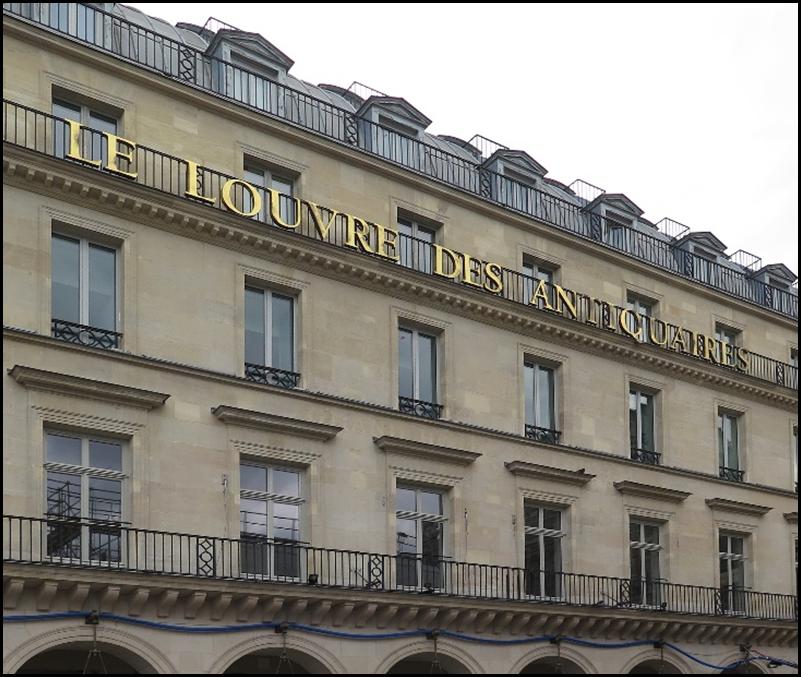 d view of the Le Louvre Des Antiquaries
name on the west side of the building from the Place du Palais Royal, 2025. Right: The walkway between the front of the building and
the interior section from the Place du Palais
Royal, 2025.
d view of the Le Louvre Des Antiquaries
name on the west side of the building from the Place du Palais Royal, 2025. Right: The walkway between the front of the building and
the interior section from the Place du Palais
Royal, 2025.
View of the building from the north side on the Rue Saint-Honore near the 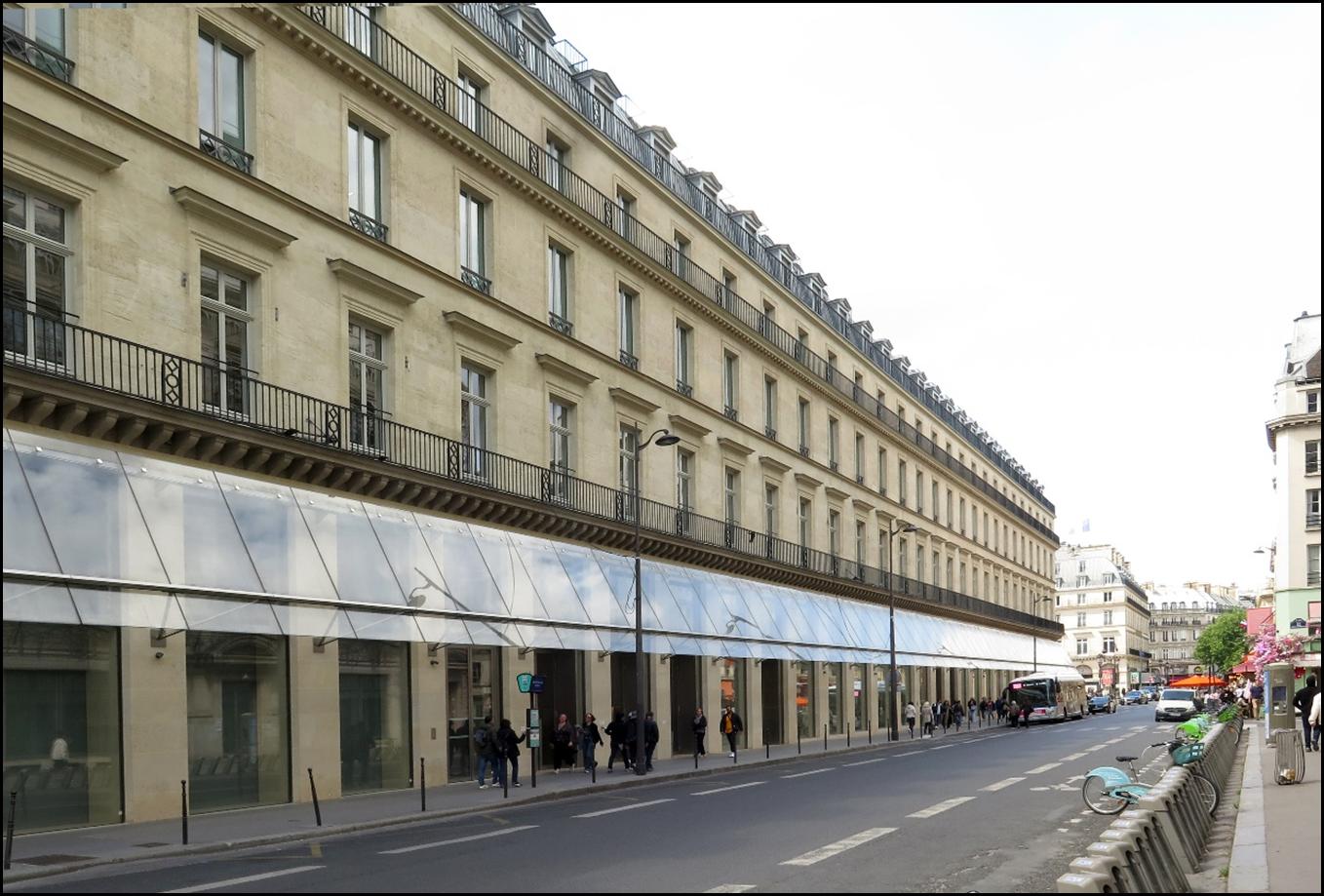 Rue
des Bons Enfants, 2025.
Rue
des Bons Enfants, 2025.
Leadenhall
Market, London
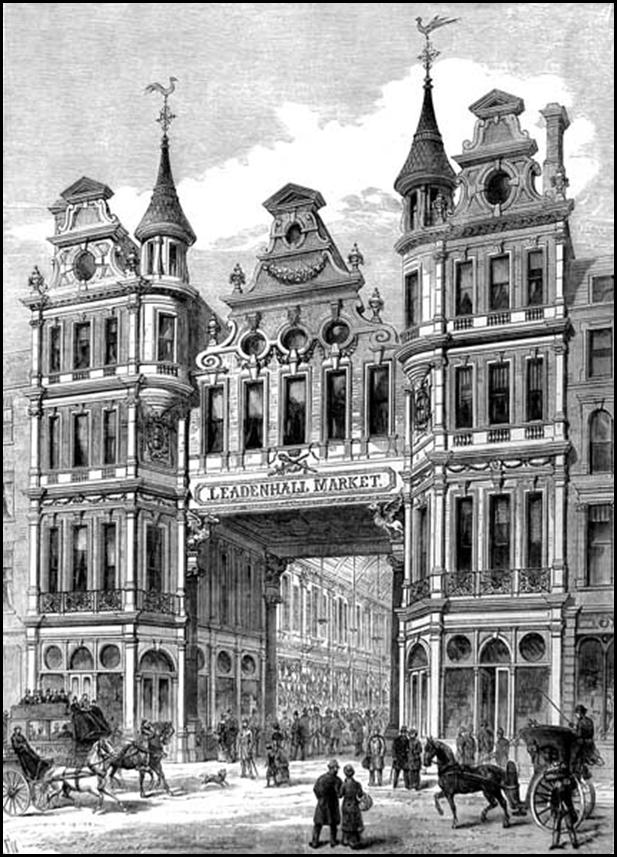
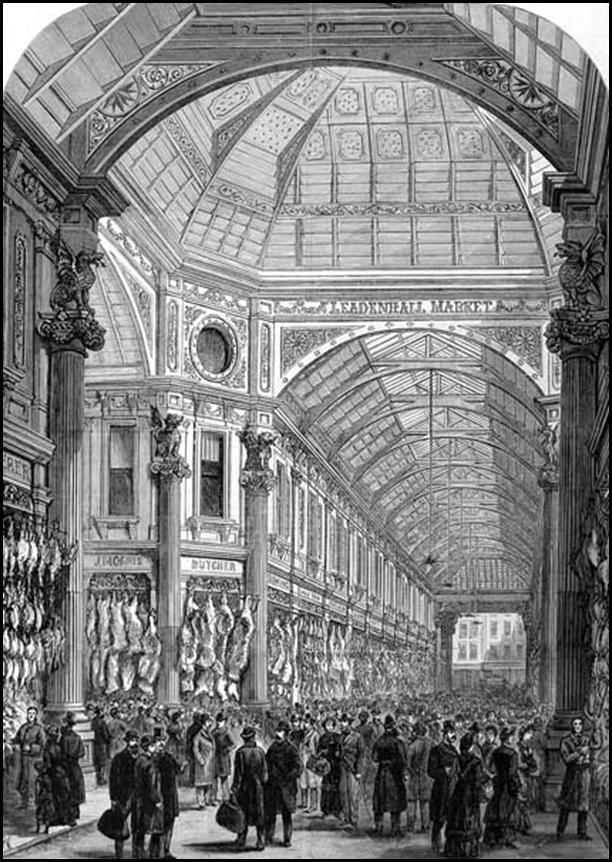 Leadenhall Market can be found at
Gracechurch Street in the eastern section of London, less than a mile east of
St. Paul’s Cathedral. It was first built
in the 14th century and is one of the oldest markets in London. Originally it was a meat, game and poultry
market but today includes commercial retailers and clothing shops. The roof and cobbled floors were designed in
1881. Then in the early 1990’s the
building was dramatically redecorated to look like it did during the Victorian
Period. Here are two drawings of the
building from 1881 and several photographs that were taken of its interior in
2023. As you can see the ceilings are
made of glass which provides additional lighting into the interior.
Leadenhall Market can be found at
Gracechurch Street in the eastern section of London, less than a mile east of
St. Paul’s Cathedral. It was first built
in the 14th century and is one of the oldest markets in London. Originally it was a meat, game and poultry
market but today includes commercial retailers and clothing shops. The roof and cobbled floors were designed in
1881. Then in the early 1990’s the
building was dramatically redecorated to look like it did during the Victorian
Period. Here are two drawings of the
building from 1881 and several photographs that were taken of its interior in
2023. As you can see the ceilings are
made of glass which provides additional lighting into the interior.
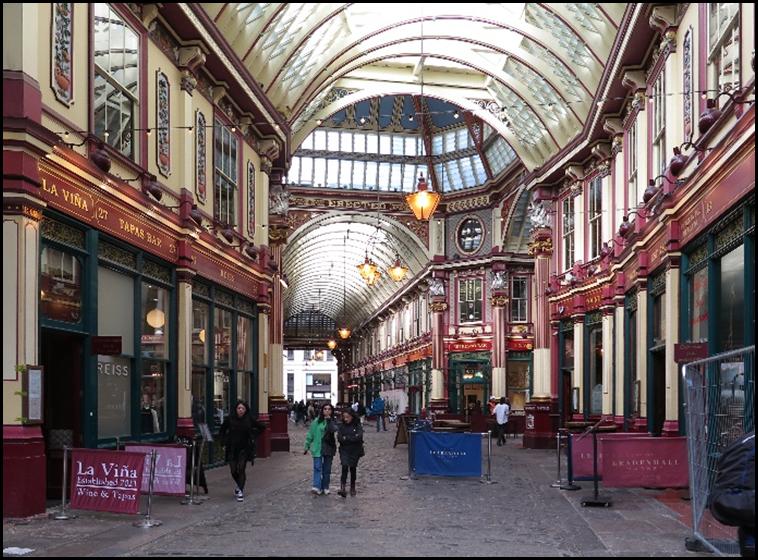
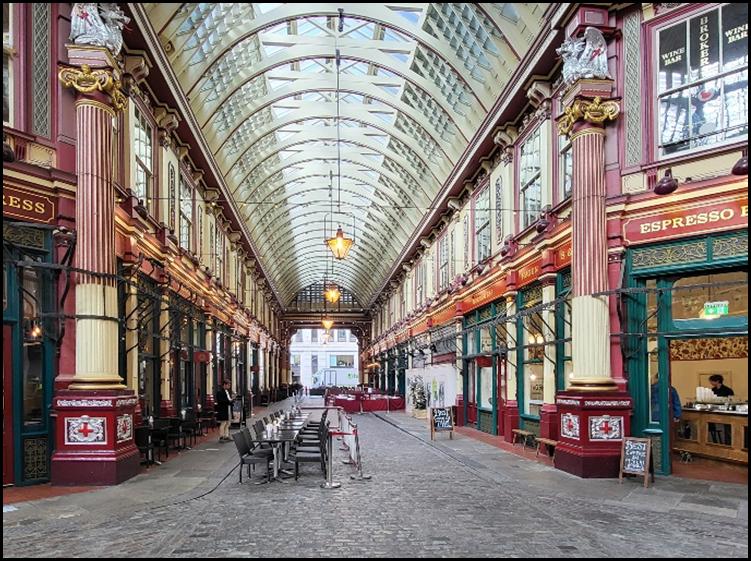
Royal
Exchange, London
 The
Royal Exchange is located at the intersection of Cornhill Street and
Threadneedle Street, about half a mile east of St. Paul’s Cathedral. It was originally built in the 16th century
as the center of commerce for the City of London. In 1571 it was ceremonially opened by
Queen Elizabeth I who gave it it’s Royal title. Unfortunately, the original building was
destroyed by fire
The
Royal Exchange is located at the intersection of Cornhill Street and
Threadneedle Street, about half a mile east of St. Paul’s Cathedral. It was originally built in the 16th century
as the center of commerce for the City of London. In 1571 it was ceremonially opened by
Queen Elizabeth I who gave it it’s Royal title. Unfortunately, the original building was
destroyed by fire
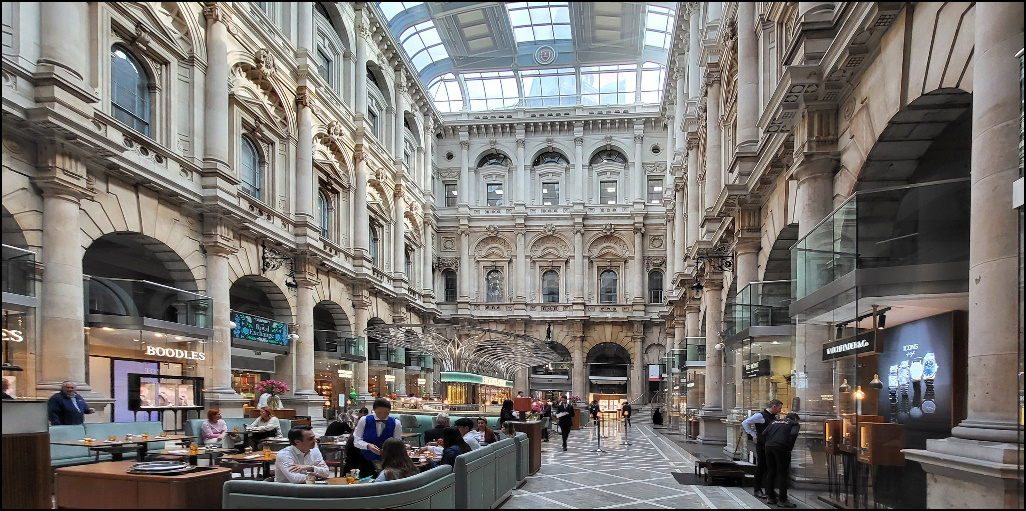 uring the Great Fire of London in 1666. A new building was constructed by 1669, however it too
was destroyed by a fire in 1838. The
building one sees today was opened by Queen Victoria in 1844. The western front of the building consists
of a portico with eight Corinthian columns supporting a pediment containing
seventeen statues that represent London merchants and foreign traders. The interior has a large open central area
which now contains a restaurant surrounded by shops on three levels. The building is quite large and fills the
entire block with shops along the exterior as well which can be seen in the
center of the photograph below. These
photographs were taken in 2023.
uring the Great Fire of London in 1666. A new building was constructed by 1669, however it too
was destroyed by a fire in 1838. The
building one sees today was opened by Queen Victoria in 1844. The western front of the building consists
of a portico with eight Corinthian columns supporting a pediment containing
seventeen statues that represent London merchants and foreign traders. The interior has a large open central area
which now contains a restaurant surrounded by shops on three levels. The building is quite large and fills the
entire block with shops along the exterior as well which can be seen in the
center of the photograph below. These
photographs were taken in 2023.

The
Strand Arcade, Sydney
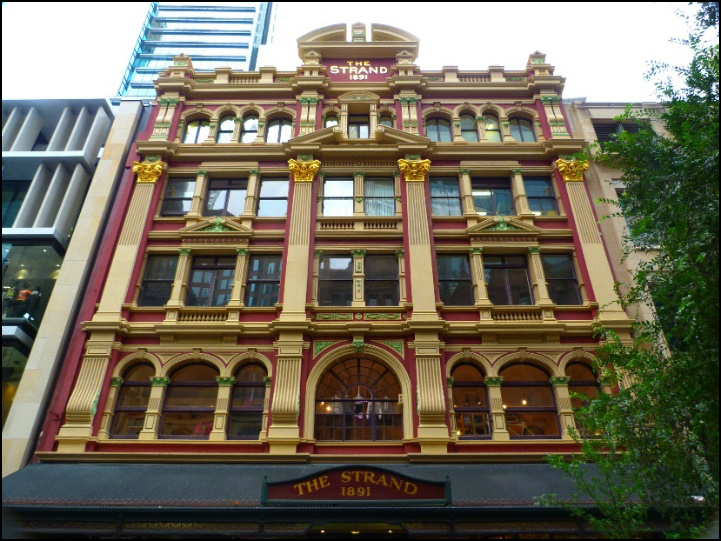 The Str
The Str and Arcade is a Victorian
style retail arcade located on Pitt Street in the central business district of
Sydney, Australia. It was built between
1890 and 1892 and was named after the famous London Street that links the City of London
with the City of Westminster. When it
opened it was known for its modern design and first-class shops. Unfortunately, fires occurred in 1976 and
1980 which resulted in a partial destruction of the arcade. When it was restored, large portions of the
interior were reconstructed to match its original appearance. The exterior facade consists of five storeys whereas the interior has three levels with an
enclosed arcade on each side of a concourse with bridges across the upper
levels. This arcade
and Arcade is a Victorian
style retail arcade located on Pitt Street in the central business district of
Sydney, Australia. It was built between
1890 and 1892 and was named after the famous London Street that links the City of London
with the City of Westminster. When it
opened it was known for its modern design and first-class shops. Unfortunately, fires occurred in 1976 and
1980 which resulted in a partial destruction of the arcade. When it was restored, large portions of the
interior were reconstructed to match its original appearance. The exterior facade consists of five storeys whereas the interior has three levels with an
enclosed arcade on each side of a concourse with bridges across the upper
levels. This arcade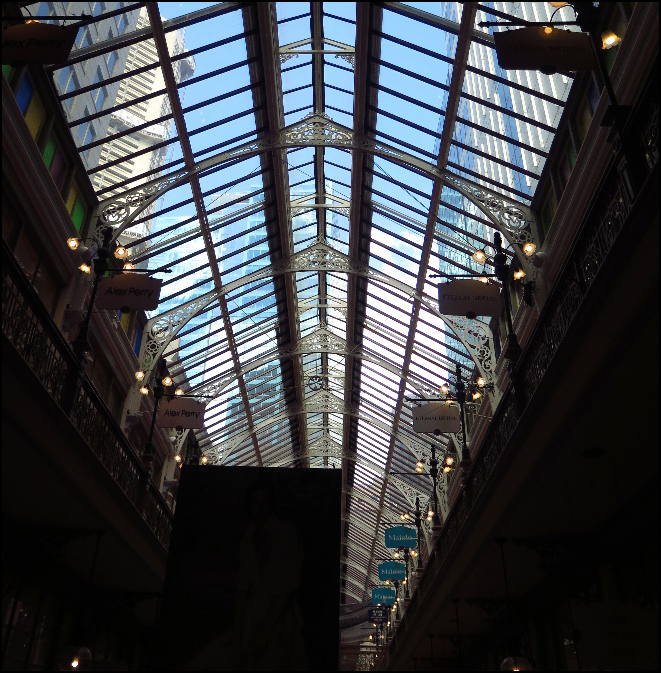 has
traditional-styled protruding galleries, cedar staircases, tiled floors, cast
iron balusters and timber framed shop
has
traditional-styled protruding galleries, cedar staircases, tiled floors, cast
iron balusters and timber framed shop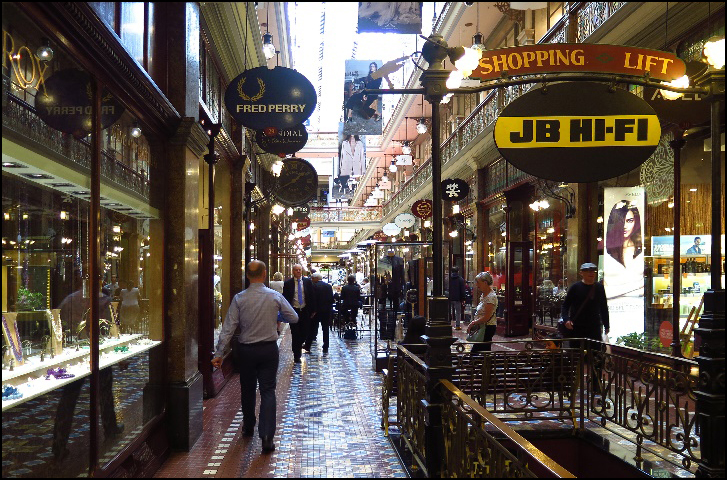 fronts.
The roof is made of tinted glass which was
designed to provide light to the arcade but with a reduced glare. The photographs seen here were taken in 2016.
fronts.
The roof is made of tinted glass which was
designed to provide light to the arcade but with a reduced glare. The photographs seen here were taken in 2016.
Queen
Victoria Building, Sydney
T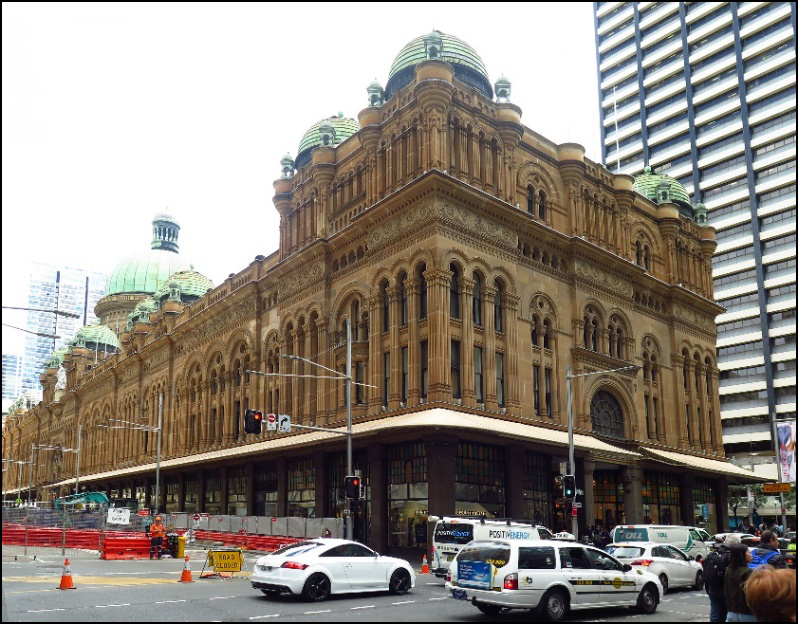 his Romanesque Revival building was constructed
in Sydney, Australia between 1893 and 1898.
It was named the Queen Victoria Building during its construction in 1897
t
his Romanesque Revival building was constructed
in Sydney, Australia between 1893 and 1898.
It was named the Queen Victoria Building during its construction in 1897
t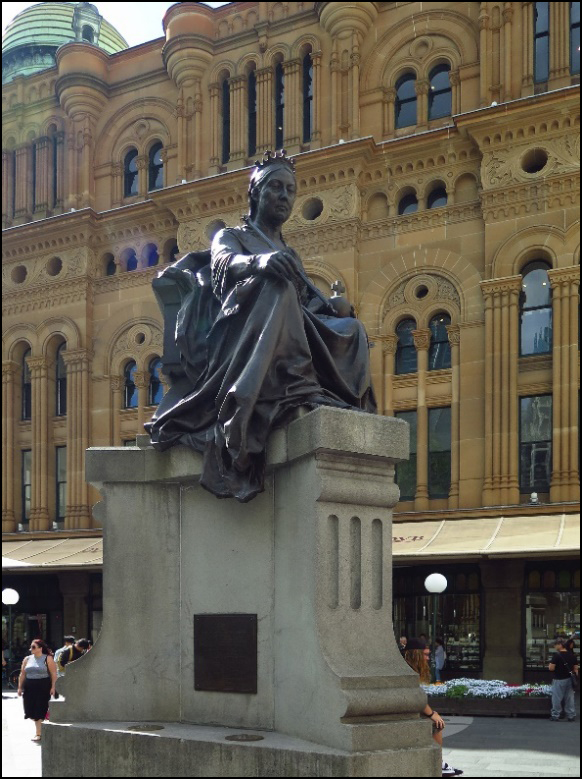 o honor the British Queen during her Diamond Jubilee. Ninety years later, in 1987, a statue of
Queen Victoria was added in front of the south entrance. When this large block long building first
opened it provided a business environment for tailors, mercers, hairdressers, florist and coffee shops as well as showrooms and a concert
hall. Over the years the building
deteriorated and it was restored from 1984-1986 at a cost of $86 million and
again between 2008 and 2009 at a cost of $48 million. Inside there are two mechanical clocks with
moving figures displaying scenes of English royalty and Australian
history. The photographs here were taken
in 2016.
o honor the British Queen during her Diamond Jubilee. Ninety years later, in 1987, a statue of
Queen Victoria was added in front of the south entrance. When this large block long building first
opened it provided a business environment for tailors, mercers, hairdressers, florist and coffee shops as well as showrooms and a concert
hall. Over the years the building
deteriorated and it was restored from 1984-1986 at a cost of $86 million and
again between 2008 and 2009 at a cost of $48 million. Inside there are two mechanical clocks with
moving figures displaying scenes of English royalty and Australian
history. The photographs here were taken
in 2016.
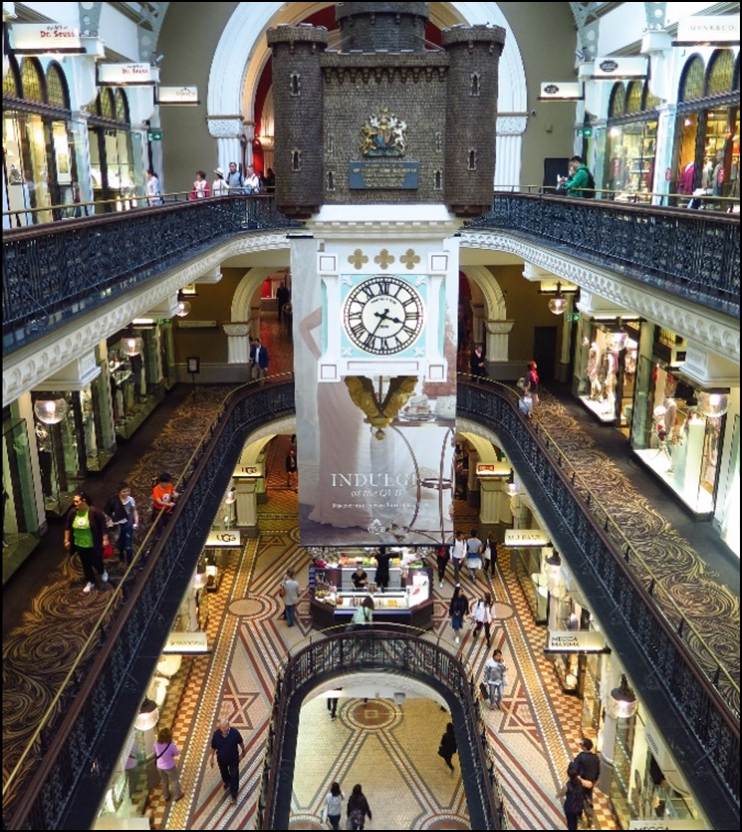

Royal
Arcade, Melbourne
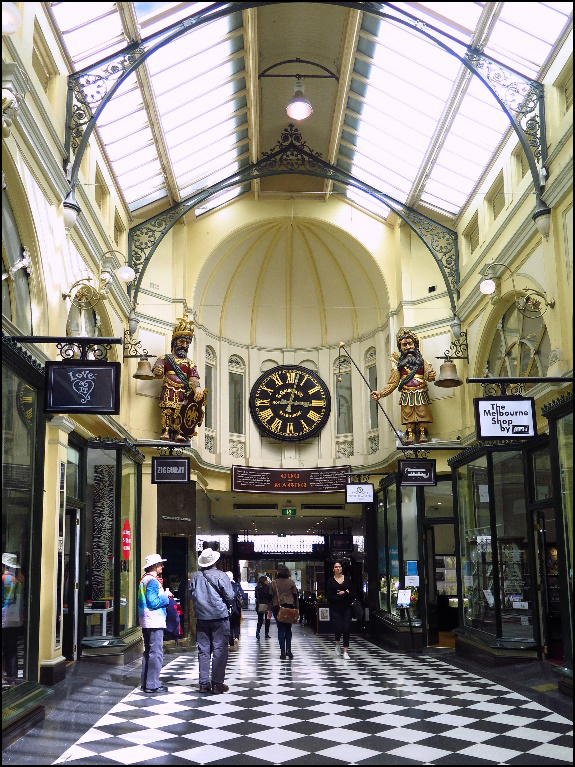 The
The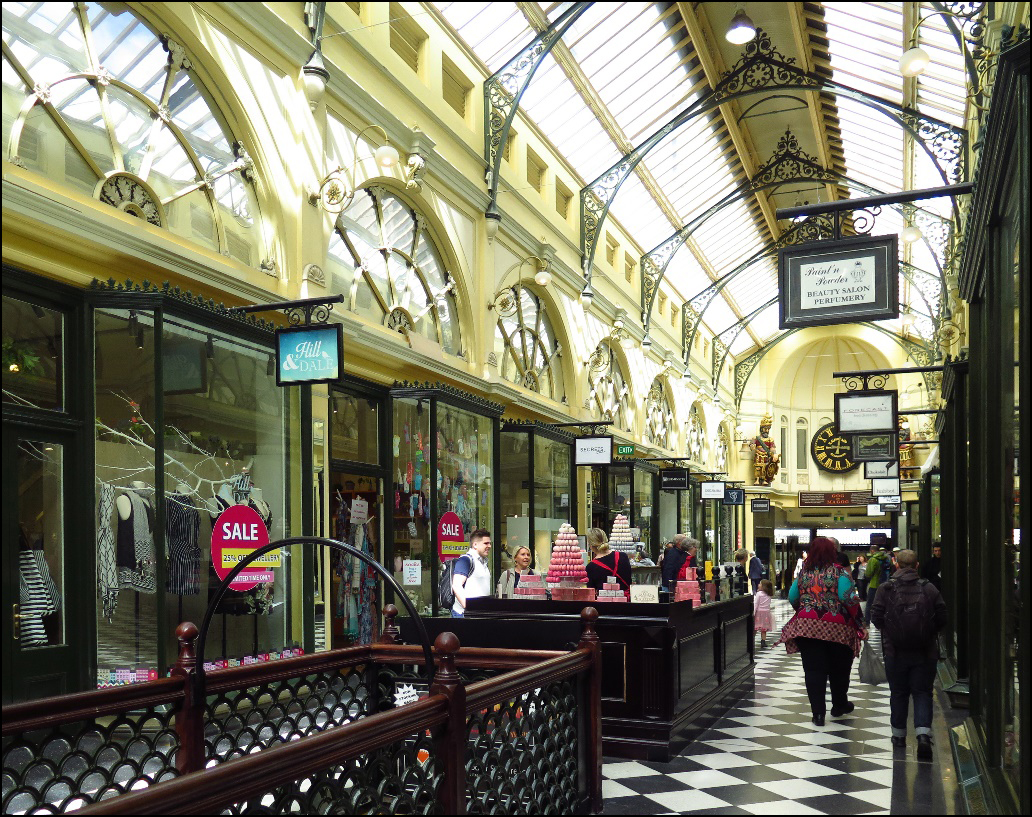 Royal Arcade was constructed on Bourke Street in the central business district
of Melbourne, Australia in 1869 and opened in 1870. It was the first arcade in Melbourne and is
the longest standing arcade in Australia. This arcade is best known for its elegant
light-filled interior and the large carved mythic figures of Gog and Magog
which were added to the southern entrance in 1893 with a clock positioned in
between them. Each hour on the hour the
arms of these two figures raise and strike bells. These two medieval warriors watch over the
southern side of the arcade and were modeled after two similar figures that
watch over Guildhall in London. They
symbolize the conflict between the ancient Britons and the Trojan
invaders. The photographs below were
taken in 2016.
Royal Arcade was constructed on Bourke Street in the central business district
of Melbourne, Australia in 1869 and opened in 1870. It was the first arcade in Melbourne and is
the longest standing arcade in Australia. This arcade is best known for its elegant
light-filled interior and the large carved mythic figures of Gog and Magog
which were added to the southern entrance in 1893 with a clock positioned in
between them. Each hour on the hour the
arms of these two figures raise and strike bells. These two medieval warriors watch over the
southern side of the arcade and were modeled after two similar figures that
watch over Guildhall in London. They
symbolize the conflict between the ancient Britons and the Trojan
invaders. The photographs below were
taken in 2016.
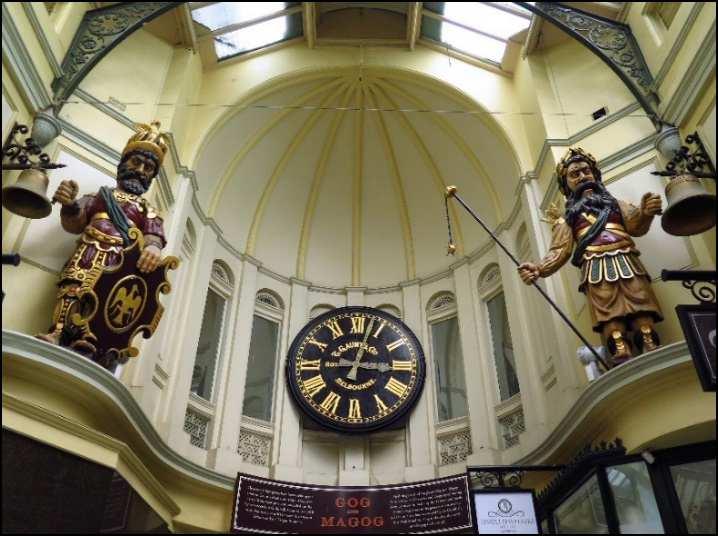
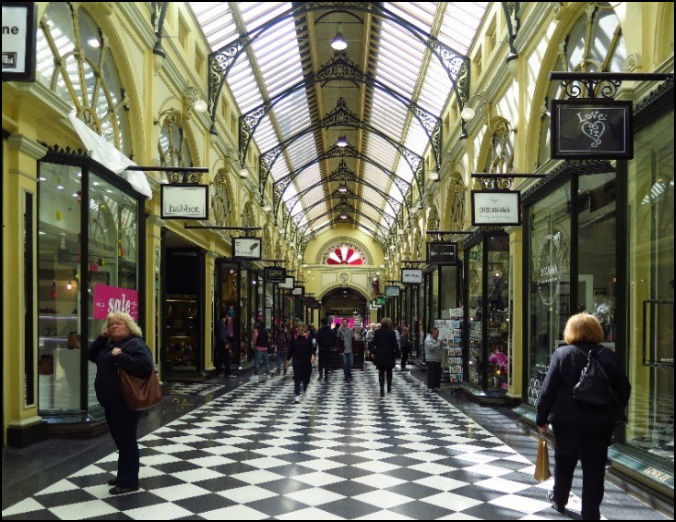
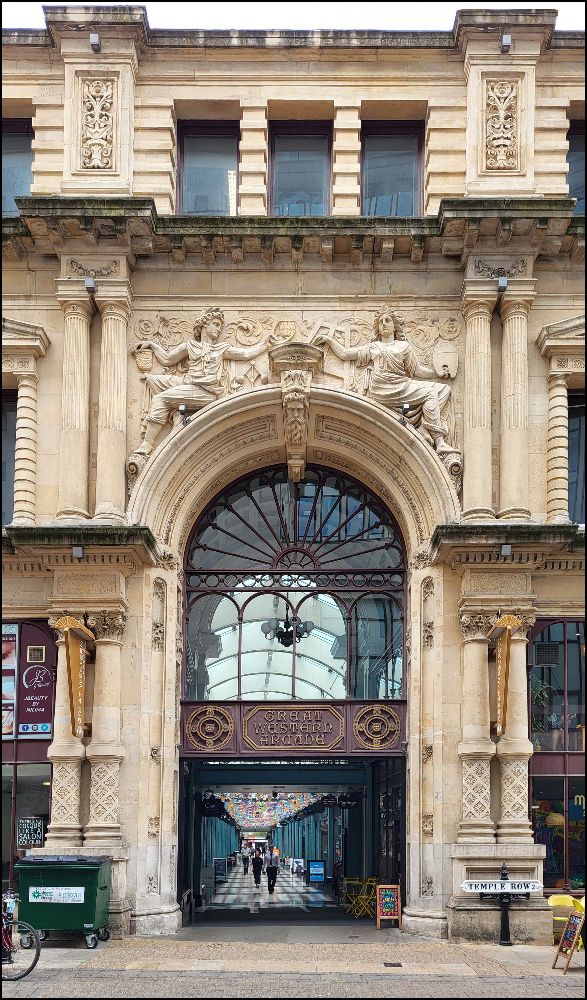 yed during
World War II and was later rebuilt.
These photographs were taken in 2022.
yed during
World War II and was later rebuilt.
These photographs were taken in 2022.

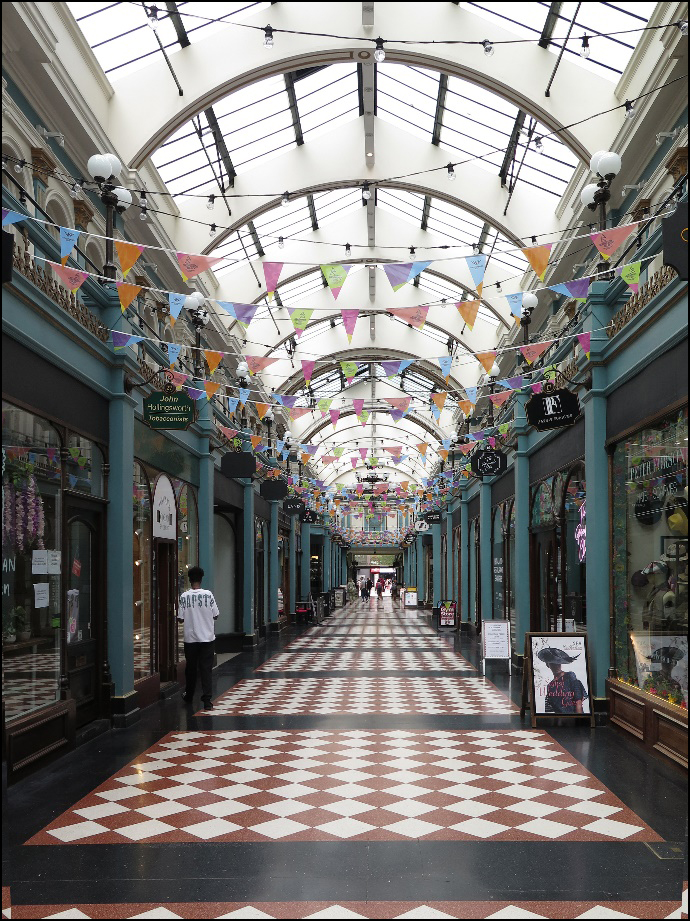
The
Argyll Arcade was originally built in 1827 between Buchanan Street linking it
to Argyll Street in the center of Glasgow, Scotland. It is one of Europe’s oldest covered shopping
arcades and Scotland’s first ever indoor shopping mall. These photographs were taken in 2023.
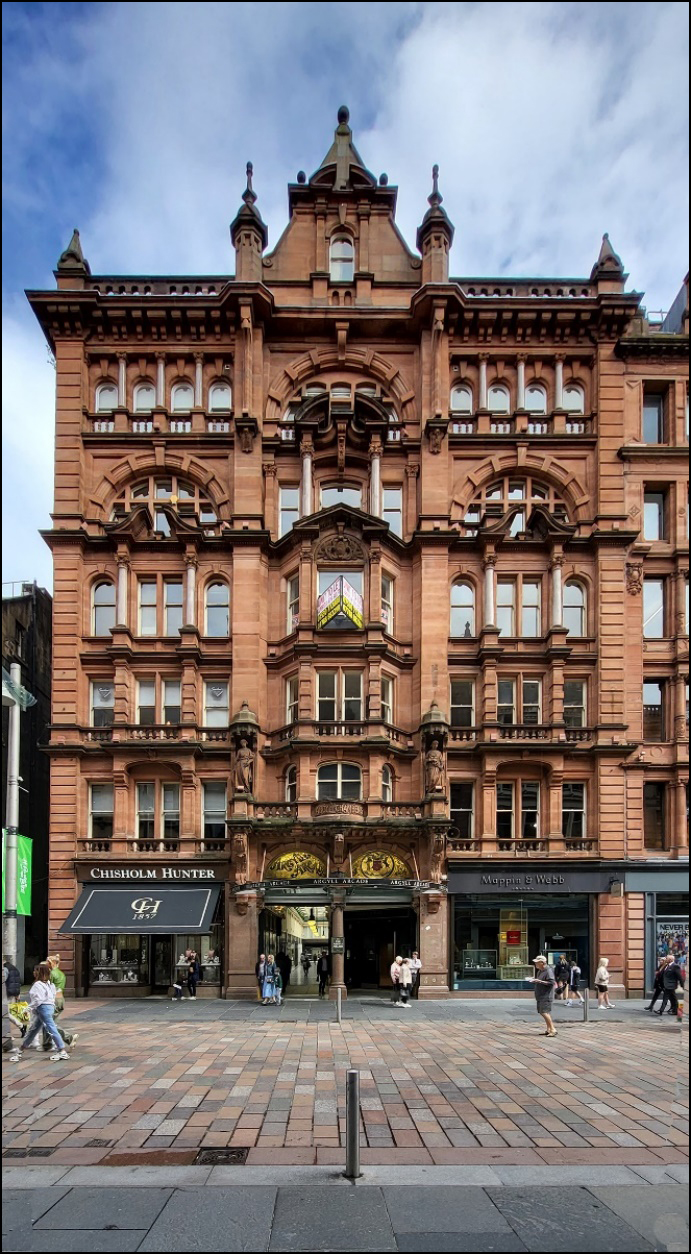
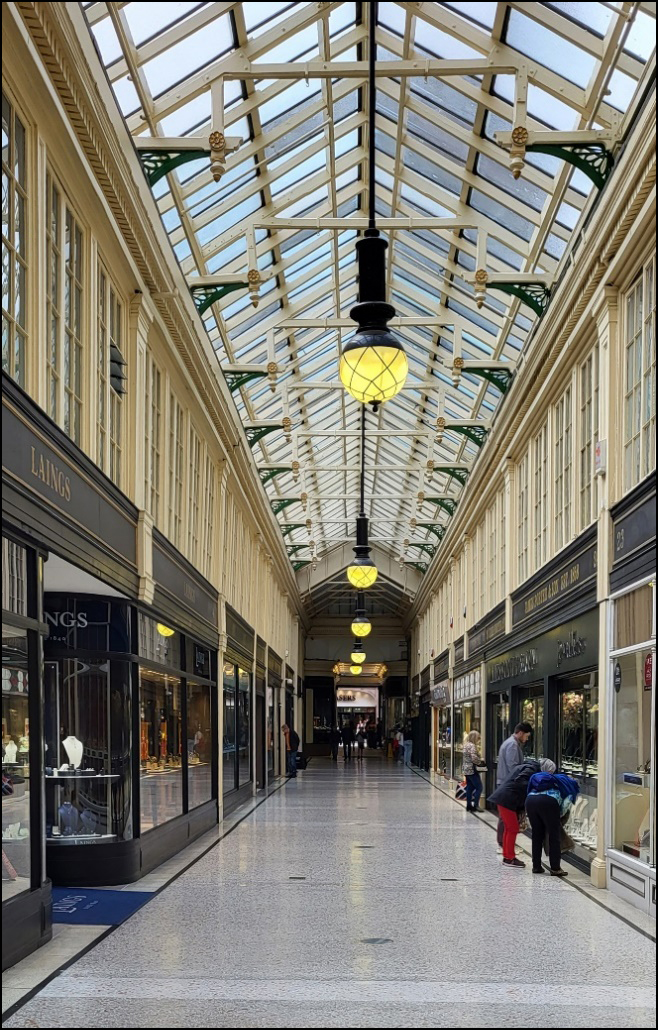
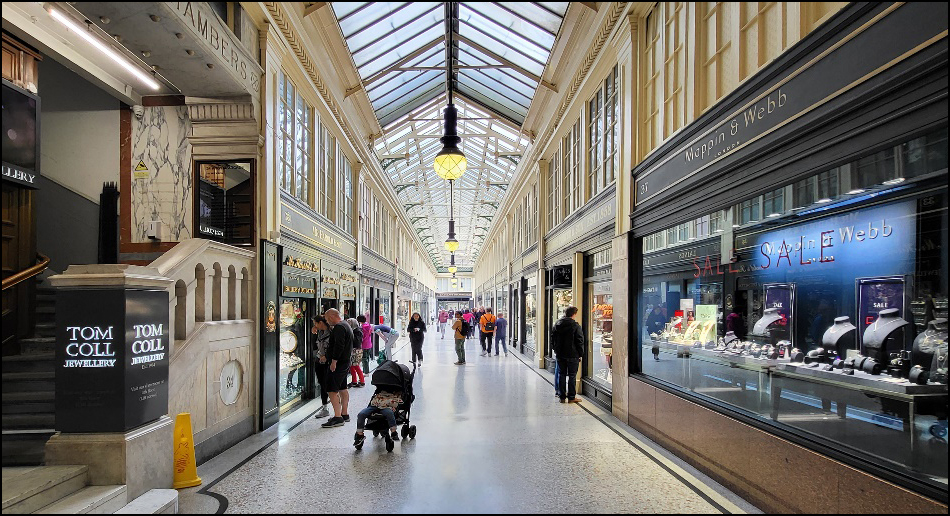
Galeries
Royales St. Hubert, Brussels
The Royal Saint-Hubert Galeries is
a shopping arcade in central Brussels, Belgium that consists of three
galleries: the King's Gallery (pictured below on the right),
the Queen's Gallery and the Princes' Gallery. These galleries were built between 1846 and
1847. The shops are separated by
pilasters and there are two upper floors.
These photographs were taken in 2025.
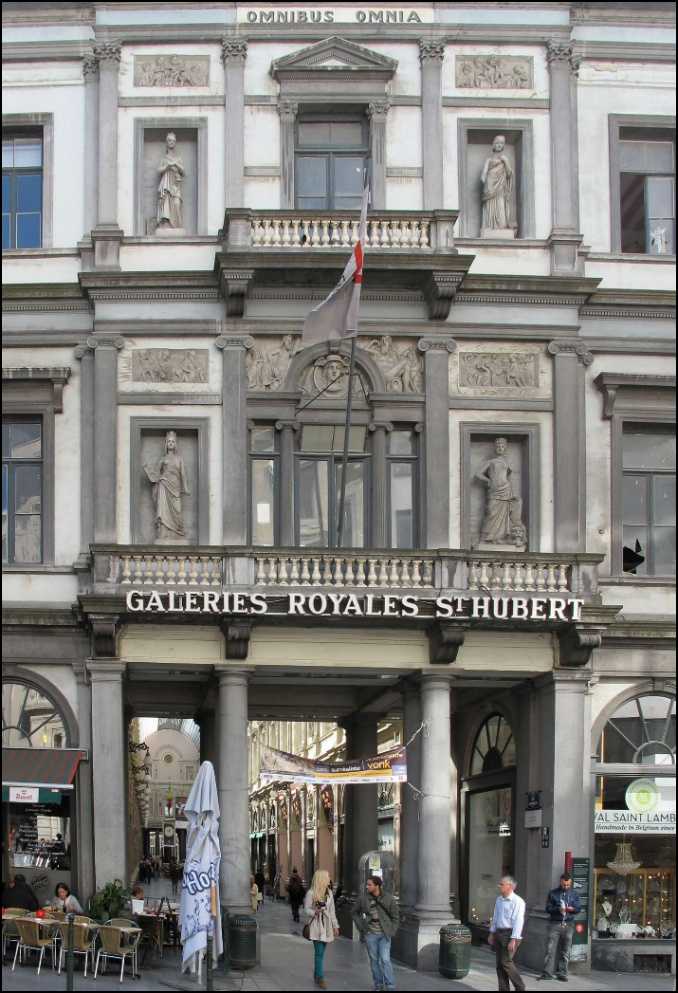

Galerie
Vivienne, Paris
T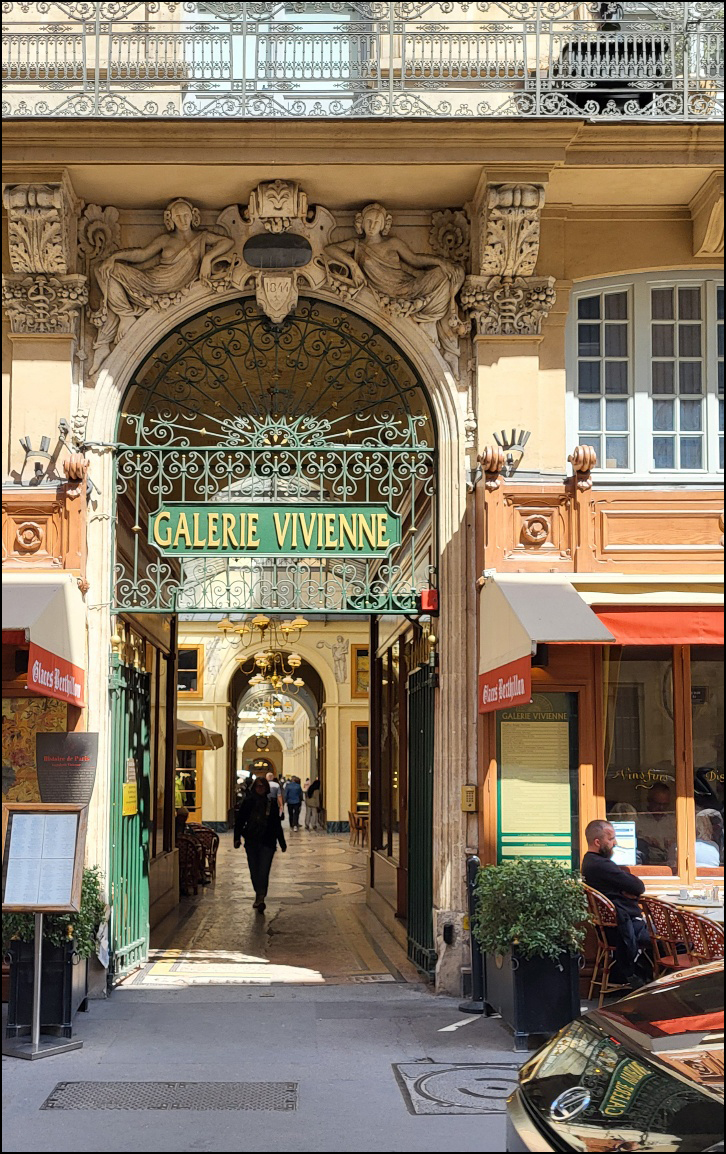 he
Galerie Vivienne was built in 1823 and inaugurated in 1826 under the name Marchoux, but soon after was renamed Vivienne. It is located between the Palais-Royal,
the P
he
Galerie Vivienne was built in 1823 and inaugurated in 1826 under the name Marchoux, but soon after was renamed Vivienne. It is located between the Palais-Royal,
the P aris Bourse (stock exchange) and the Grands Boulevards. Originally it attracted many visitors with
its tailor shops, cobblers, wine shop, restaurant, bookstore, draper,
confectioner, print-seller, and so on.
The gallery lost part of its appeal when some of the prestigious shops moved
to the
Champs-Elysees. However, since 1960, the
gallery has once again become very active. It features fashion and home
furnishings, and haute couture shows held there. The installation of the Jean
Paul Gaultier and Yuku Torii shops in
1986 helped with the resurrection of the gallery. It now houses many shops selling ready-to-wear
and decorative items.
aris Bourse (stock exchange) and the Grands Boulevards. Originally it attracted many visitors with
its tailor shops, cobblers, wine shop, restaurant, bookstore, draper,
confectioner, print-seller, and so on.
The gallery lost part of its appeal when some of the prestigious shops moved
to the
Champs-Elysees. However, since 1960, the
gallery has once again become very active. It features fashion and home
furnishings, and haute couture shows held there. The installation of the Jean
Paul Gaultier and Yuku Torii shops in
1986 helped with the resurrection of the gallery. It now houses many shops selling ready-to-wear
and decorative items.
The
author of this book thinks this is the most beautiful shopping arcade that she
has ever visited. And why is that? Because of the interesting glass ceilings and
the wonderfully decorated floors. These
photographs were taken in 2025.
Left:
view of the gallery entrance on the Rue des Petits Champs. Right: the rotunda and cupola.
More
views of the interior of the Galerie Vivienne.
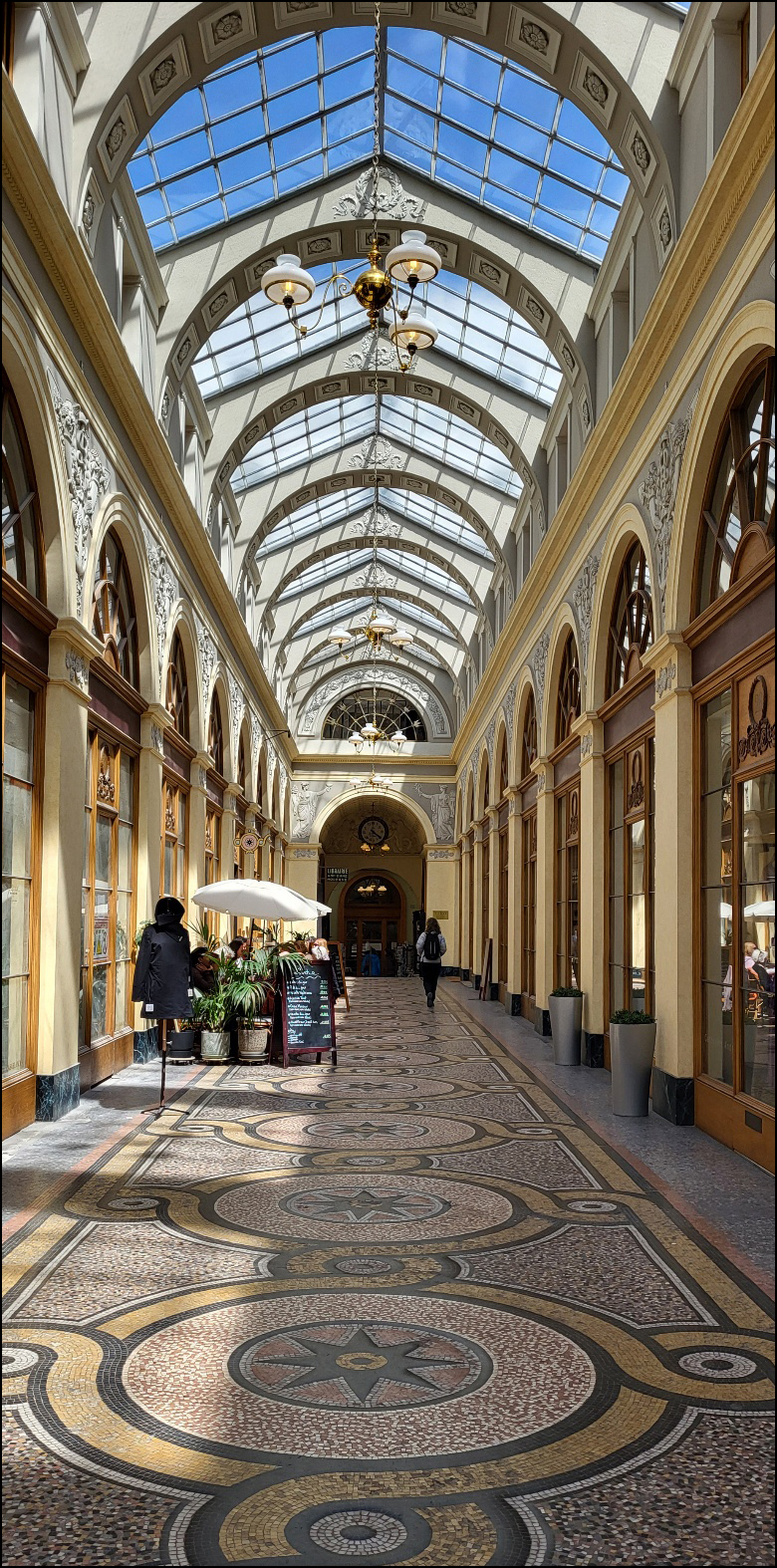
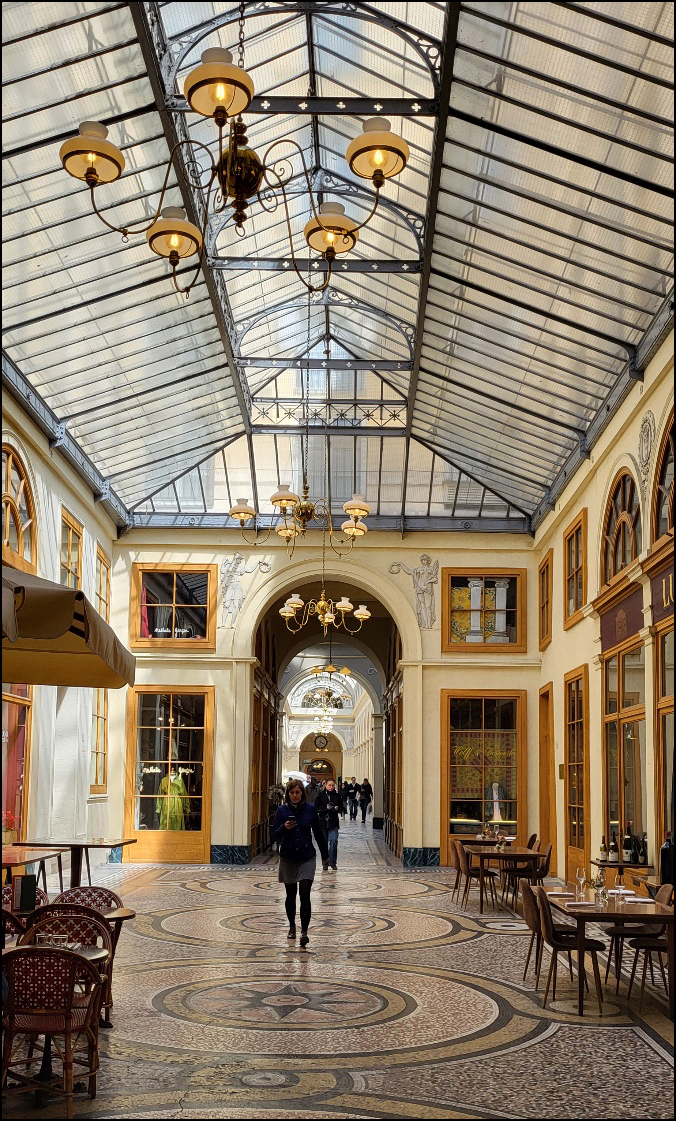
Passage
Jouffroy, Paris
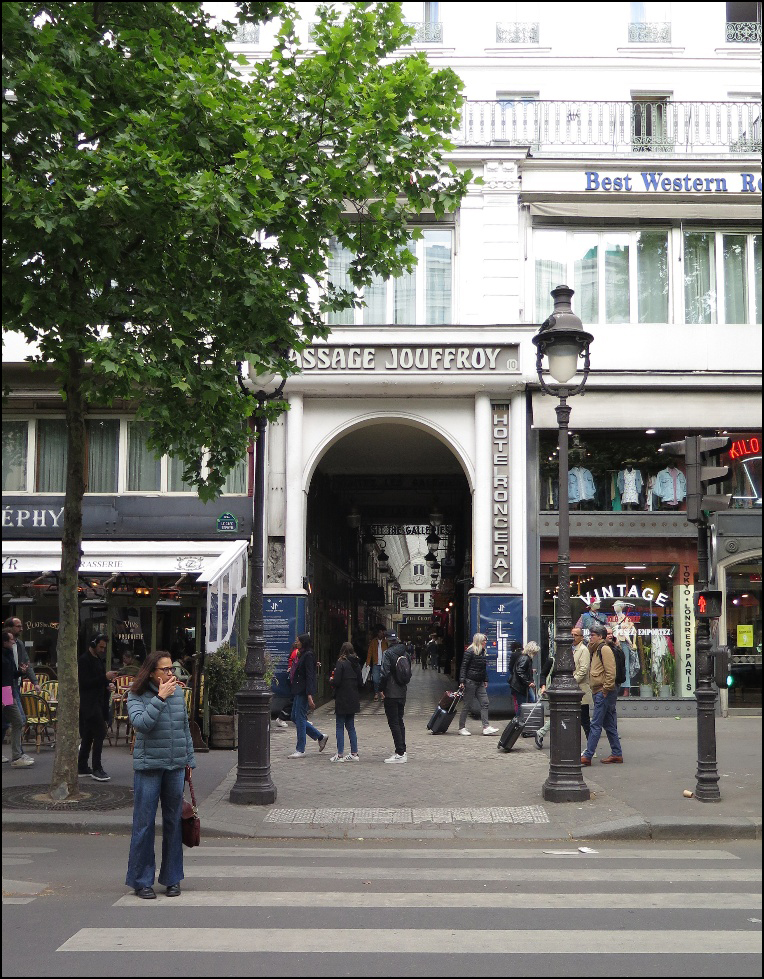 he Pa
he Pa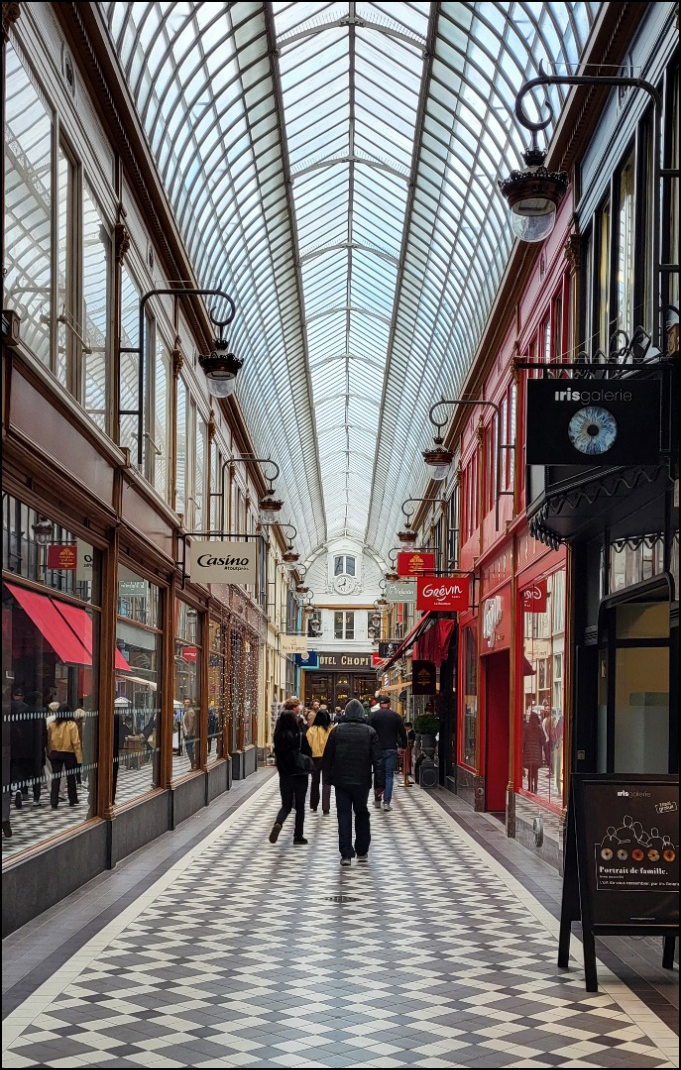 ssage
Jouffroy is one of several Victorian Era shopping centers built in the 9th
arrondissement district of Paris, France. It is located between the Boulevard
Montmaretre on the south and the Rue de la Grange-Batelière on the north. Like most other shopping malls from the mid
to late 19th century, it is covered by a canopy of metal and glass. The Passage Jouffroy was built in 1845 along
the line of the Passage des Panoramas in order to
capitalize on the popularity of the latter whose entrance is on the other side
of the Boulevard Montmaretre. The floor is paved with a geometric pattern
composed of white, gray and black squares. The Passage Jouffroy represents an important
stage in the technological evolution of the 19th century and the mastery of
iron structures. It is the first Parisian passage built entirely of metal and
glass. Only the decorative elements are
wooden. It is also the first passage heated by the ground. These photographs were taken in 2025.
ssage
Jouffroy is one of several Victorian Era shopping centers built in the 9th
arrondissement district of Paris, France. It is located between the Boulevard
Montmaretre on the south and the Rue de la Grange-Batelière on the north. Like most other shopping malls from the mid
to late 19th century, it is covered by a canopy of metal and glass. The Passage Jouffroy was built in 1845 along
the line of the Passage des Panoramas in order to
capitalize on the popularity of the latter whose entrance is on the other side
of the Boulevard Montmaretre. The floor is paved with a geometric pattern
composed of white, gray and black squares. The Passage Jouffroy represents an important
stage in the technological evolution of the 19th century and the mastery of
iron structures. It is the first Parisian passage built entirely of metal and
glass. Only the decorative elements are
wooden. It is also the first passage heated by the ground. These photographs were taken in 2025.
Passage
Panoramas, Paris
 The
P
The
P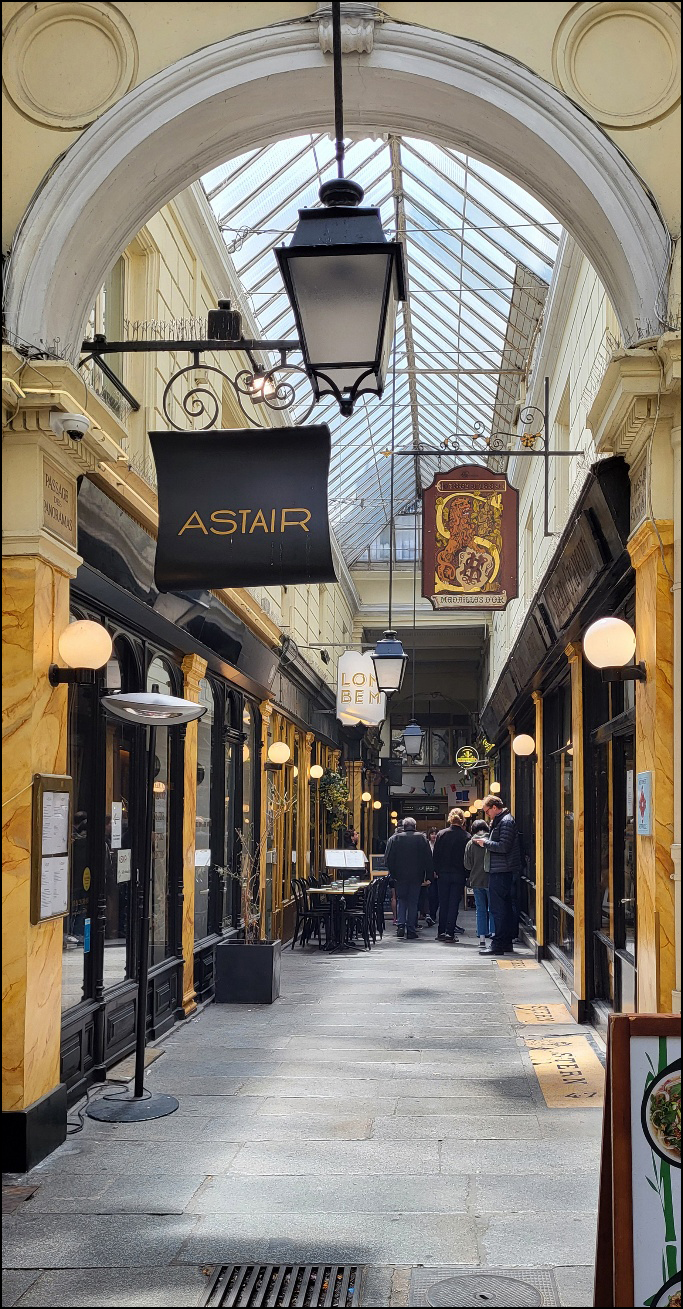 assage des Panoramas is the oldest of the covered shopping arcades in
Paris. It is located between the
Boulevard Montmartre on the north and the Rue Saint-Marc on the south. It was built in 1799 and opened in 1800,
becoming the first covered commercial passageway in Europe. By
1867, there were approximately 183 covered passages in Paris but many were
demolished during the Haussmann’s renovation of Paris. Only
25 survived into the 21st century and all but one are in the district on the
right bank of the Seine River. These
photographs were taken in 2025.
assage des Panoramas is the oldest of the covered shopping arcades in
Paris. It is located between the
Boulevard Montmartre on the north and the Rue Saint-Marc on the south. It was built in 1799 and opened in 1800,
becoming the first covered commercial passageway in Europe. By
1867, there were approximately 183 covered passages in Paris but many were
demolished during the Haussmann’s renovation of Paris. Only
25 survived into the 21st century and all but one are in the district on the
right bank of the Seine River. These
photographs were taken in 2025.
Two
Other Interesting Places to Visit in Paris Related to Avery Needle Cases
No
visit to Paris would be complete for someone interested in Avery needle cases
without a stop at two of the city’s most popular historical sites, the Arc de
Triomphe and the Eiffel Tower. And why
is that? During the Victorian Period W.
Avery and Son, the needle manufacturer from Redditch, England, registered two
unique needle case designs t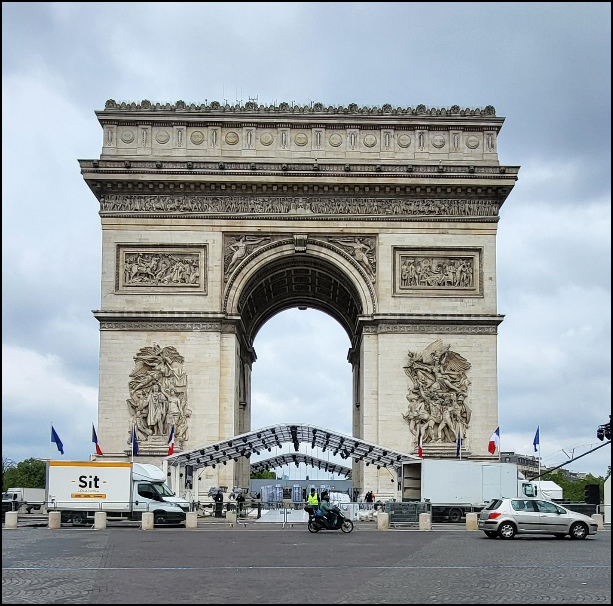 hat represent these two buildings.
hat represent these two buildings.
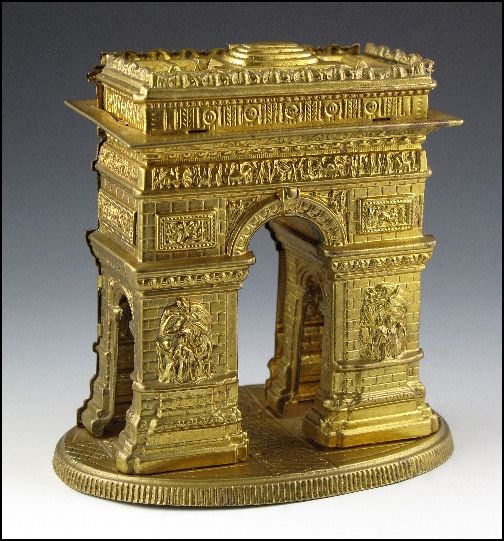
A
current view of the Arc de Triomphe is seen below along with the Avery needle
cases shaped like it. Avery registered
the Arc de Triomphe needle case in 1879[2],
just months after the 1878 Exposition Universelle (World’s Fair) in Paris. It seems most likely that Avery got the idea
for this needle case after having a booth at the fair[3]
and seeing what one of his competitors
was selling in their booth. W. Bartlett
& Son created a needle case specifically for the fair which was named the
Arts & Industry[4] with the
words “Souvenir de l'Exposition 1878” inscribed on it
(pictured below on the left). It
must have been a popular souvenir for middle- and upper-class women who
attended the fair an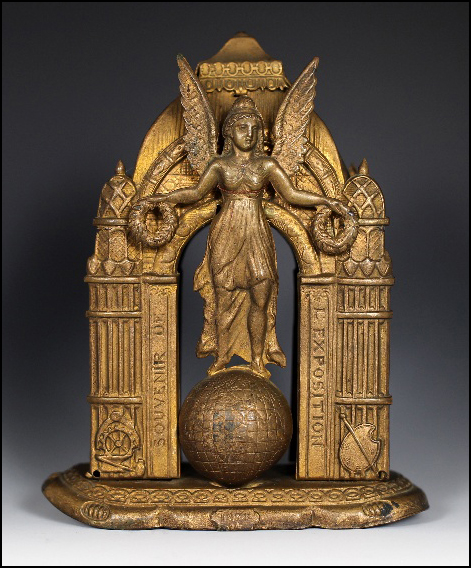 d stitched during the Victorian Period. After the fair ended and Avery was back in
England, he decided to create the Arc de Triomphe needle case because at the
time is was one of the top tourist attractions in
Paris. The actual Arc de Triomphe[5]
was commissioned by Napoleon in 1806; however, it wasn’t
completed until 1836. It was designed
in the neo-classical style and was based on the famous Arch of Titus in Rome,
Italy. The arch honors those who fought and died for France during the
French Revolution and Napoleonic Wars. The
Arc de Triomphe monument is located in the middle of
the Place Charles de Gaulle,
a circular square on the west bank of the Seine River on the
famous Champs-Elyséess. Visiting the actual Arc de Triomphe will make
the needle case in your collection even more special.
d stitched during the Victorian Period. After the fair ended and Avery was back in
England, he decided to create the Arc de Triomphe needle case because at the
time is was one of the top tourist attractions in
Paris. The actual Arc de Triomphe[5]
was commissioned by Napoleon in 1806; however, it wasn’t
completed until 1836. It was designed
in the neo-classical style and was based on the famous Arch of Titus in Rome,
Italy. The arch honors those who fought and died for France during the
French Revolution and Napoleonic Wars. The
Arc de Triomphe monument is located in the middle of
the Place Charles de Gaulle,
a circular square on the west bank of the Seine River on the
famous Champs-Elyséess. Visiting the actual Arc de Triomphe will make
the needle case in your collection even more special.
The
second Avery style nee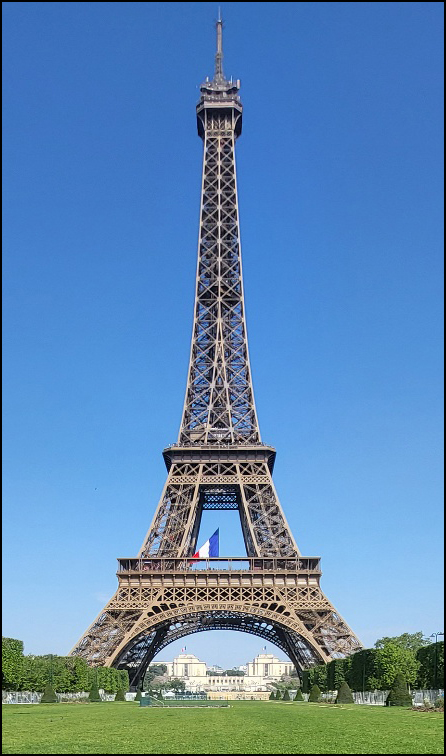 dle case is based on the famous Parisian building known
as the Eiffel Tower. Avery registered
the design in 1888[6] and had
it manufactured in time for the 1889 Exposition Universelle in Paris. The actual Eiffel Tower[7]
was designed by the French structural engineer Gustave Eiffel for the 1889
Exposition Universelle. A competition
was held in 1884 to design the expositions centerpiece structure. Several
years later in 1886, Mr. Eiffel’s tower was selected as the winner of the
competition. Although construction began in early 1887, it wasn’t
totally accessible to the public until nine days after the exposition opened in
May 1889 due to difficulties involving the elevators. The Eiffel Tower is located at the Champ de Mars on the east side
of the Seine River a
dle case is based on the famous Parisian building known
as the Eiffel Tower. Avery registered
the design in 1888[6] and had
it manufactured in time for the 1889 Exposition Universelle in Paris. The actual Eiffel Tower[7]
was designed by the French structural engineer Gustave Eiffel for the 1889
Exposition Universelle. A competition
was held in 1884 to design the expositions centerpiece structure. Several
years later in 1886, Mr. Eiffel’s tower was selected as the winner of the
competition. Although construction began in early 1887, it wasn’t
totally accessible to the public until nine days after the exposition opened in
May 1889 due to difficulties involving the elevators. The Eiffel Tower is located at the Champ de Mars on the east side
of the Seine River a cross the river from the Trocadéro. It is the tallest
building in Paris and one of the most recognized structures in the world.
This is what the building looks like today (right).
cross the river from the Trocadéro. It is the tallest
building in Paris and one of the most recognized structures in the world.
This is what the building looks like today (right).